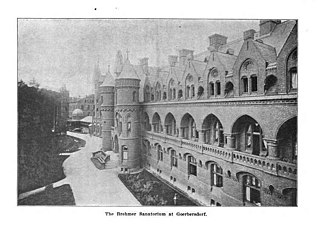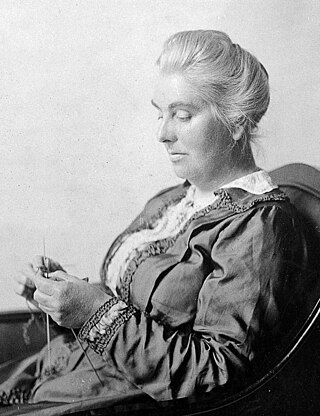
A sanatorium, also sanitarium or sanitorium, are antiquated names for specialised hospitals, for the treatment of specific diseases, related ailments and convalescence. Sanatoriums are often in a healthy climate, usually in the countryside. The idea of healing was an important reason for the historical wave of establishments of sanatoriums, especially at the end of the 19th- and early 20th centuries. One sought, for instance, the healing of consumptives, especially tuberculosis or alcoholism, but also of more obscure addictions and longings of hysteria, masturbation, fatigue and emotional exhaustion. Facility operators were often charitable associations such as the Order of St. John and the newly founded social welfare insurance companies.

The Waverly Hills Sanatorium is a former sanatorium located in the Waverly Hills neighborhood of Louisville, Kentucky.

Muirdale Tuberculosis Sanatorium, also called Muirdale Tuberculosis Hospital, was built in 1914–15 by Milwaukee County, Wisconsin. It was located near the corner of Highway 100 and Watertown Plank Road in Wauwatosa and named after noted Wisconsin naturalist John Muir. Maximum capacity in 1923 was 350 patients, but in later years this figure rose to over 600, including a 100-bed Children's Cottage, or Preventorium, devoted to the treatment of young children.

University Hospital Hairmyres is a district general hospital in the Hairmyres neighbourhood of East Kilbride, South Lanarkshire, Scotland. The hospital serves one of the largest elderly populations in Scotland. It is managed by NHS Lanarkshire.

Paimio Sanatorium is a former tuberculosis sanatorium in Paimio, Southwest Finland, designed by Finnish architect Alvar Aalto. Aalto received the design commission having won the architectural competition for the project held in 1929. The building was completed in 1933, and soon after received critical acclaim both in Finland and abroad. The building served exclusively as a tuberculosis sanatorium until the early 1960s, when it was converted into a general hospital. Today the building is owned by Turku University Hospital but is not functioning as a hospital; rather, the building has functioned as private rehabilitation center for children since 2014. The sanatorium has been nominated to become a UNESCO World Heritage Site.

Glenn Dale Hospital was a tuberculosis sanatorium and isolation hospital in Glenn Dale, Maryland, in the United States. It is a large facility, consisting of 23 buildings on 216 acres (87 ha), that was built in 1934 and closed in 1981 due to asbestos.

Lac-Édouard is a municipality in the Mauricie region of the province of Quebec in Canada. Its village centre is located along the Canadian National Railway at the north end of the namesake Lake Édouard.

Between 1873 and 1945, Saranac Lake, New York, became a world-renowned center for the treatment of tuberculosis, using a treatment that involved exposing patients to as much fresh air as possible under conditions of complete bed-rest. In the process, a specific building type, the "cure cottage", developed, built by residents seeking to capitalize on the town's fame, by physicians, and often by the patients themselves. Many of these structures are extant, and their historic value has been recognized by listing on The National Register of Historic Places.

Glen Lake Children's Camp is a former children's camp for victims of tuberculosis. The camp was part of the Glen Lake Sanatorium on the border of Minnetonka and Eden Prairie, Minnesota. Although the main sanatorium buildings were demolished in 1993, the children's camp portion remained intact. The camp is Minnesota's only known surviving camp for children who had tuberculosis, and it reflects the philanthropic efforts of its founders, George H. and Leonora Christian. It was listed on the National Register of Historic Places on August 5, 1999.

The Adirondack Cottage Sanitarium was a tuberculosis sanatorium established in Saranac Lake, New York in 1885 by Dr. Edward Livingston Trudeau. After Trudeau's death in 1915, the institution's name was changed to the Trudeau Sanatorium, following changes in conventional usage. It was listed under the latter name on the National Register of Historic Places in 1995.

Glen Lake Sanatorium, a tuberculosis treatment center serving Hennepin County in Minnesota, opened on January 4, 1916, with a capacity of 50 patients, and closed in 1976. In 1909, the Minnesota State Legislature had passed a bill authorizing the appointment of county sanatorium boards and appropriating money for the construction of county sanatoriums. Glen Lake Sanatorium was the fifth of fourteen county sanatoria that opened in Minnesota between 1912 and 1918. Glen Lake was the first U.S. tuberculosis sanatorium to be accredited by the American Medical Association.The sanatorium had its own post office, and the mailing address was Glen Lake Sanatorium, Oak Terrace, Minnesota, until the surrounding area was incorporated into the City of Minnetonka.

The Ellis Island Immigrant Hospital was a United States Public Health Service hospital on Ellis Island, in New York Harbor, that operated from 1902 to 1951. The hospital is part of the Statue of Liberty National Monument. While the monument is managed by the National Park Service as part of the National Parks of New York Harbor office, the south side of Ellis Island, including the hospital, is managed by the non-profit Save Ellis Island Foundation and has been off-limits to the general public since its closing in 1954.

The Arkansas Tuberculosis Sanatorium Historic District is a United States Historic District south of Booneville, Arkansas that was listed on the National Register of Historic Places in October 2006. The district encompasses the former relocation center for Arkansans diagnosed with tuberculosis and an administration building built in the Art Deco style in 1909. It is one of the largest and best-preserved surviving complexes of its type in the country.

Jane Harriett Walker CH was an English medical doctor who first implemented the open-air method of treating tuberculosis in England. She was appointed a Companion of Honour in 1931.

The Minnesota State Sanatorium for Consumptives, also known as the Ah-Gwah-Ching Center, was opened in 1907 to treat tuberculosis patients. The name "Ah-Gwah-Ching" means "out-of-doors" in the Ojibwe language. The center remained a treatment center for tuberculosis until January 1, 1962. During that time, it treated nearly 14,000 patients. In 1962, it became a state nursing home known as the Ah-Gwah-Ching Nursing Home, serving geriatric patients with various mental and physical illnesses. At its peak in the 1970s, the nursing home had as many as 462 patients.
Government Hospital of Thoracic Medicine, popularly known as the Tambaram TB Sanatorium, is a major state-owned hospital situated in Chennai, India. The hospital is funded and managed by the state government of Tamil Nadu. It was founded in 1928.
The town of Colorado Springs, Colorado played an important role in the history of tuberculosis in the era before antituberculosis drugs and vaccines. Tuberculosis management before this era was difficult and often of limited effect. In the 19th century, a movement for tuberculosis treatment in hospital-like facilities called sanatoriums became prominent, especially in Europe and North America. Thus people sought tuberculosis treatment in Colorado Springs because of its dry climate and fresh mountain air. Some people stayed in boarding houses, while others sought the hospital-like facilities of sanatoriums. In the 1880s and 1890s, it is estimated that one-third of the people living in Colorado Springs had tuberculosis. The number of sanatoriums and hospitals increased into the twentieth century. During World War II, medicines were developed that successfully treated tuberculosis and by the late 1940s specialized tuberculosis treatment facilities were no longer needed.

Ethan Allen School for Boys was a reform school in Delafield Town, Wisconsin which operated in a former tuberculosis sanitorium from April 1959 until June 2011, when it was abolished and the inmates moved to Lincoln Hills School in Irma. It was operated by the Wisconsin Department of Corrections.

The Firland Sanatorium was Seattle's municipal tuberculosis treatment center. It opened on May 2, 1911, and closed on October 30, 1973.




























